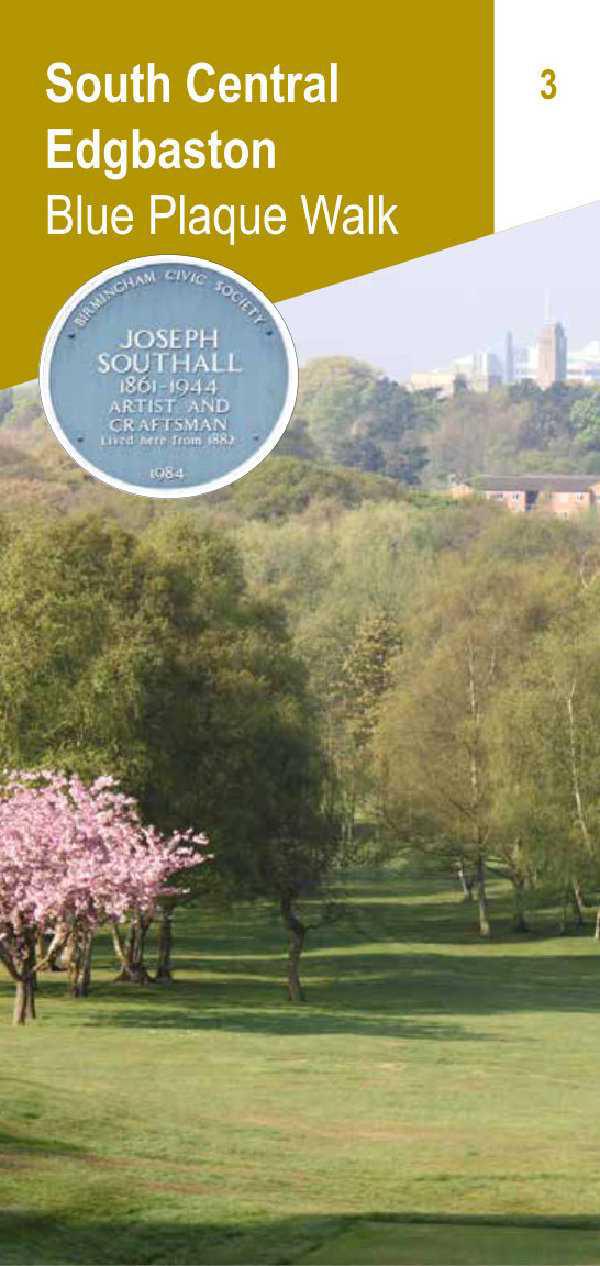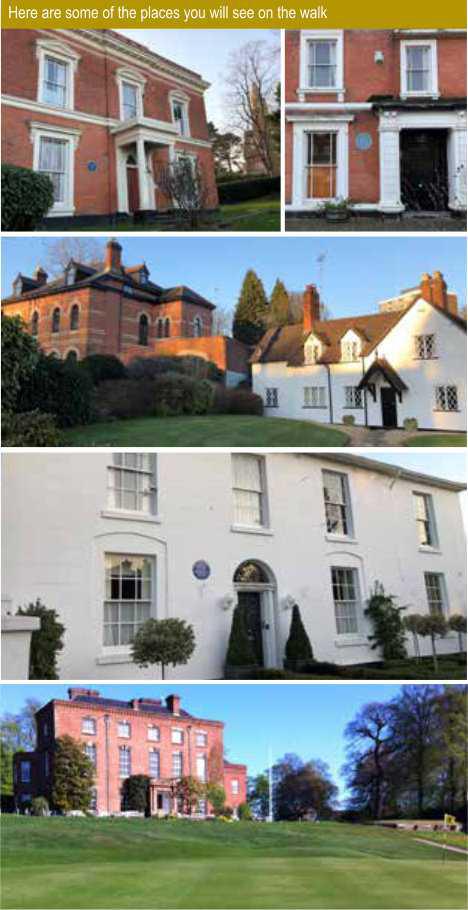Walking distance 2.8 miles / 4.5 km
Category: Easy
Places to eat, drink and relax in Edgbaston: www.edgbastonvillage.co.uk
For a Brief history of Edgbaston click here.
Instructions start from Five Ways station but being circular, the walk can be started at any point. As you walk around look for the blue plaques at the locations indicated on the sketch map at the bottom of this page.
The nearest refreshment points along the walk are on Islington Row, followed by Harborne Road and Highfield Road in Edgbaston Village.
From station turn right and then right again into Wheeley’s Road.
S1 RICHARD CADBURY (1835 – 1899) - 17 Wheeley’s Road
Richard Barrow Cadbury, manufacturer and philanthropist, was the second son of the Quaker John Cadbury, founder of Cadbury’s cocoa and chocolate company. Together with his younger brother George (S7), he took over the family business in 1861. Richard used his artistic talent to design fancy boxes for the chocolates which improved sales. In 1878 they acquired 14 acres of land four miles (6 km) south of Birmingham where they opened a new factory. Over the following years, more land was acquired and a model village built for the workers. This became known as Bournville. Richard Cadbury lived here from 1861 to 1871. He bought Moseley Hall in 1889 and later donated it to the City of Birmingham, for use as a children’s convalescent home. It is now part of Moseley Hall Hospital, an NHS elderly care and convalescent facility.
S2 JOSEPH STURGE (1793-1859) - Edencroft, Wheeley’s Road
Born a Quaker in Gloucestershire, Joseph Sturge moved to Birmingham in 1822. He went into business with his brother Charles, becoming prosperous by importing grain. Joseph ceased to be an active partner from 1831 and concentrated on causes and public life. He is best known for his campaigns to abolish slavery, working with William Wilberforce among others. However, he disagreed with the policy of gradual emancipation and in 1831, with his father-in-law, James Cropper, formed a pressure group within the Society for the Abolition of Slavery that campaigned for a new act of Parliament. When the Abolition of Slavery Act was passed in 1833, Sturge was disappointed that it granted compensation to slave owners and substituted a system of unpaid apprenticeships. So, in 1836 he visited the West Indies where he collected evidence to demonstrate the flaws in the legislation. On his return he gave evidence before a committee of the House of Commons. As a result of his campaign the apprenticeship system was terminated in 1838. After several failed bids to enter politics, he became a pacifist. A statue of Sturge stands outside the Marriott Hotel at Five Ways.
Turn left into St. James’s Road and continue until it becomes Charlotte Road (after the junction with Packenham/Ryland Roads). The next 2 plaques are on the right.
S3 CONSTANCE NADEN (1858-1889) - 20 Charlotte Road
Constance Naden, poet, scientist and philosopher, was born in Edgbaston. Her mother died soon after giving birth and so she was brought up in this house by her wealthy grandparents and lived here for most of her life. She was educated at Mason College (the forerunner of Birmingham University) where she was elected the first female associate and is commemorated by a marble bust at the University’s Cadbury Research Library, which also houses her notebooks. She was accepted as an original thinker in both science and philosophy.
The University of Birmingham awards a Constance Naden medal, originally for ‘best competitive philosophical essay’ at Mason College, now for best Master’s degree thesis in the Arts Faculty. Although Constance never married, she wrote poetry providing a comic perspective on romantic relationships and stereo-typical gender roles. At the same time, she was an advocate of social reform particularly championing the cause of women and was active at the forefront of women’s intellectual progress at the end of 19th century. She died young at the age of 31 and is buried in Key Hill cemetery in Birmingham’s Jewellery Quarter where her grandfather had made his fortune.
S4 JOSEPH SOUTHALL (1861-1994) - 13 Charlotte Road
Joseph Southall was born in Nottingham to a Quaker family. His father died shortly afterwards and he moved to Edgbaston to live with his mother’s family. In 1878 he was articled to a leading architects’ practice while studying painting part-time at the Birmingham School of Art. Both institutions were heavily influenced by John Ruskin and the Arts and Crafts movement, but Southall was frustrated by his architectural training, feeling that an architect should have a broader understanding of disciplines such as painting and carving. With this in mind, in 1882 he went to Europe and became particularly enthralled with early Italian frescoes, executed in tempera. On returning home, Southall conducted his first experiments in tempera painting at the School of Art but also excelled in architectural drawing and continued to paint in oils.
After some setbacks, he produced a series of large mythological studies in tempera, which established his reputation and were widely exhibited across Europe and the USA. Southall’s politics were strongly influenced by the pacifism of his Quaker faith. At the outbreak of WW1 in 1914 he switched his allegiance from the Liberal Party to the anti-war Independent Labour Party, for whose Birmingham branch he served as secretary from 1914 until 1931. He was elected an Associate of the Royal Birmingham Society of Artists in 1898 and a full Member in 1902, a member of the Arts and Crafts Exhibition Society in 1903 and of the Art Workers Guild and Union Internationale des Beaux-Arts et des Lettres in 1910. In 1907 he was prominent in the first exhibition dedicated to the work of the Birmingham Group at the Fine Art Society in London, and in 1910 he held a very successful one-man exhibition in Paris.
Turn right into Gough Road, then left into Carpenter Road. Continue up to Wellington Road and cross it. Walk to the right, crossing Sir Harry’s Road and Priory Road. Go past the Church to reach Edgbaston Golf Club. If the gates are open you can walk up to the house (formerly Edgbaston Hall) to view plaque number S5.
S5 WILLIAM WITHERING (1741-1799) - Edgbaston Golf Club
Son of a surgeon, William Withering was born in Shropshire but studied medicine at Edinburgh Medical School. He then came to Birmingham, worked at the General Hospital and became a member of the Lunar Society. He is famous for discovering the medicinal value of digitalis, an extract of the foxglove plant, in relieving congestive heart failure. In 1785, Withering published reports of his clinical trials in ‘An account of the Foxglove and some of its Medical Uses’ and was elected fellow of the Royal Society. Erasmus Darwin tried to discredit Withering and take credit for researching the foxglove himself, probably through jealousy, but failed and in 1787 Withering was elected as fellow of the Linnaean Society in recognition of his contribution to botany. He lived here at Edgbaston Hall, which he rented from the Calthorpe family and narrowly escaped the Birmingham riots of 1791 when St. Bartholomew’s Church next door was badly damaged. A memorial plaque to Withering can be seen in the church.
From Edgbaston Golf Club carefully cross the dual carriageway into Arthur Road and walk down to Ampton Road, which is on your left. A short way up on the right is no.8.
S6 MAJOR GEM (1819- 1881) - 8 Ampton Road
Major Thomas Henry Gem, known as Harry Gem, was an English lawyer, soldier, writer and sportsman. With his friend Augurio Perera, he is credited as the earliest inventor of the game of lawn tennis. Perera and Gem created a new set of rules for a rackets game, known as pelota, lawn rackets or lawn tennis. The game was reportedly first played by Gem and Perera on the croquet lawn at Perera’s Edgbaston home in 1865. Gem had also encouraged the creation of a volunteer army corps for Warwickshire, through which he eventually gained the title of Major of the 1st Warwickshire Rifle Volunteer Corps. In 1872 both Gem and Perera moved to Leamington Spa and there they established the world’s first lawn tennis club. Gem had also been a member of Edgbaston Archery Society, and whilst there is no proof lawn tennis was introduced there by Gem, it had developed in popularity to the point that the society was renamed Edgbaston Archery and Lawn Tennis Society in 1877.
Continue up Ampton Road, turn right into Carpenter Road; left at its junction with Arthur Road; up Wheeley’s Road to St. James Road. Turn left up to George Road corner.
S7 GEORGE CADBURY (1839-1922) - 32 George Rd
The 3rd son of John Cadbury, George was also a philanthropic social reformer and taught without payment every Sunday at the Birmingham Adult School. From the age of 22 he ran the chocolate factory with his brother Richard until the latter’s untimely death in 1889. George then took over with his sons and nephews on the Board. The Cadburys were renowned as good employers, providing their workers with a pension as well as affordable rented housing with wash houses, a hospital, schools and reading rooms. Born in Edgbaston, George lived in this house for 10 years from 1871. He acquired other properties as his fortunes grew and donated them to good causes. One is now the Royal Orthopaedic Hospital and another is the only Quaker study centre in Europe. He co-founded The Birmingham Civic Society in 1918.
Cross St. James Road to the other part of George Road and look for number 46 on your right.
S8 WILLIAM GEAR (1915-1997) - 46 George Road
William Gear was a Scottish-born painter noted for his abstract work. He studied at Edinburgh College of Art and exhibited at the Scottish Royal Academy. He later travelled on a scholarship to Italy, France, Albania, Greece and Turkey. He enlisted in the army in the 2nd World War and became responsible for securing artworks in British occupied Germany. Post war he worked and lived in Paris, and was a member of ‘CoBrA’ an avant-garde group of artists producing brightly coloured, child-like art. He then moved back to UK, eventually becoming Head of Fine Art at Birmingham, College of Art, and a member of the Royal Birmingham Society of Artists.
Continue to the dual carriageway, turn right to station.
How to get there
Edgbaston is an elegant leafy suburb just one mile west of Birmingham city centre.
Public Transport
By bus - using Hagley Road towards Quinton or buses to Harborne.
By train - from New Street travel to Five Ways station. For more information visit: www.networkwestmidlands.com
By car - Edgbaston Village is easily accessible by car. Car parking is available at pay and display car parks, and there is limited free on-street car parking.
Walk or Cycle - It is easy to walk and cycle to. Within the Edgbaston Village there are a number of cycle stands.
Walk developed by Heritage Volunteers from The Arts Society Birmingham Evening and sponsored by Calthorpe Residents’ Society and Calthorpe Estates, plus supported by the Local Innovation Fund.







